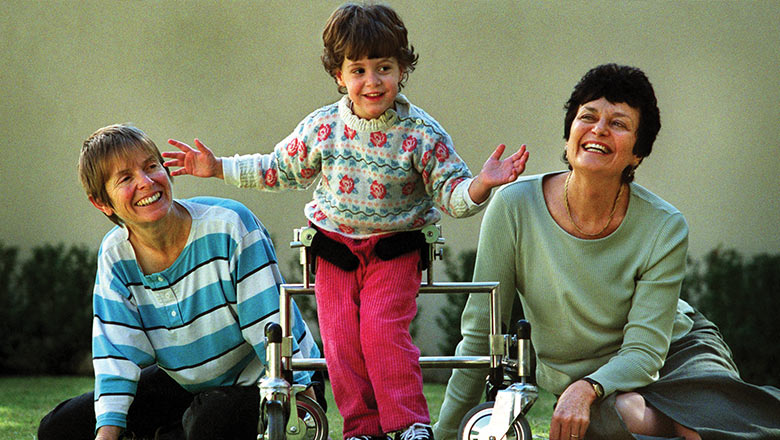Problems tracked to earlier in pregnancy
Many parents of a child with cerebral palsy are baffled about what caused the condition and worry that they are at higher risk of it occurring again.
Finding the answer to their concerns has long been a research focus of Professor Fiona Stanley, who set up in the late 1970s what is now one of the longest-standing cerebral palsy registers in the world.
Her team at The Kids Research Institute Australia, including Associate Professor Eve Blair, contributed to a significant discovery. Cerebral palsy is not only the result of birth trauma and the lack of oxygen supply during delivery, widely accepted as the cause by the medical fraternity for over a century.
They found that greater intervention at birth, such as performing more caesarean sections, was not reducing the birth prevalence of cerebral palsy, as had been anticipated by obstetricians.
Instead most cases were linked to events earlier in pregnancy which disrupted normal brain development.
This finding enabled the focus to shift away from birth, and stem the tide of litigation that was plaguing the obstetric field.
“Eve really led this work with a major case-control study comparing risks for CP kids and other kids and we published extensively on how few children were likely to have received their brain damage at birth,” Professor Stanley said.
“It not only showed that causes of cerebral palsy were rare in labour but it highlighted that cerebral palsy is made up of many different syndromes and that we needed to look earlier in pregnancy if we were to shed light on cause.
“Our data were used extensively in obstetric litigation cases and we made the case over 20 years ago for a national disability no-fault insurance scheme. This finding also shifted research into earlier periods of pregnancy – which is challenging since it is hard to measure risks in utero.”
Associate Professor Blair said she did not think a cure was a possibility in the foreseeable future but it was important to keep chipping away at the causes with a view to prevention and encourage women to make healthy lifestyle choices.
“The misconception that birth asphyxia is the major cause of CP is still rife,” she said. “The baby assists in the birth process – a compromised infant, particularly a neurologically compromised infant, is likely to have more difficulties during birth because it does not assist appropriately. Therefore many children who later are labelled as CP do have some difficulties during birth, but usually they are insufficient to damage a normal infant.”
Prematurity and low birth weight are also associated with higher rates of cerebral palsy.
Professor Stanley said the WA Cerebral Palsy Register, which is run by Linda Watson, was established to answer the key question of whether the dramatic increase in survival of preterm infants had resulted in an increase in children with cerebral palsy.
“We found that it had and that it was a function of how many children at each gestational age died or survived,” she said.
“More understanding of the pathways into preterm cerebral palsy and how this might be reduced by improvements in neonatal intensive care has meant that the proportion of very preterm infants with cerebral palsy is now falling.
“The rates of cerebral palsy are still closely related to how early you are born and whether you have restricted growth in utero, suggesting other causes than just being born early.
“Since our register was set up, many possible causal factors have been identified and there is increasing research interest now in all these problems and how to prevent them.” These factors include neuronal migration disorders, genetic syndromes, genetic propensities, teratogens, multiple pregnancy, inflammation, thrombotic disorders, intra-uterine strokes, infections and head trauma after birth.
Kerry Naso, the mother of 22-year-old David who raised awareness of cerebral palsy as the Telethon child in 2001, cannot speak highly enough of the work of these cerebral palsy investigators.
A parent representative to The Kids Research Institute Australia, Ms Naso said it was a shock when David was diagnosed at 11 months of age. She admitted she did blame herself at the time, wondering if it was the vitamins she’d taken.
“I would love to hear in my lifetime the reason why,” she said. “It would be so great if they could just come out and say it was not something that the mum did. I lived with that guilt, having had two kids with disabilities.
“After a while though, you don’t blame yourself anymore, you just try to make the best of things for your child.”
What is cerebral palsy?
Cerebral palsy is defined by motor disability due to damage of the developing brain and is frequently accompanied by other neurological impairments such as intellectual or sensory. It is the most common physical disability in childhood, affecting about one in 500 children.
Decades of records
The WA Cerebral Palsy Register was set up in 1977 to monitor incidence of the condition, enable research into the causes and assist in the planning of services for people with cerebral palsy. It records cases of cerebral palsy for people born or living in WA from 1956 onwards. It has since been incorporated into the Western Australian Register of Developmental Anomalies.
What’s next
According to Professor Stanley, collating more data is crucial.
“I think that the register must continue to monitor the trends in cerebral palsy, in all the different syndromes and to ensure that the CP registers across Australia are analysed together as they are more powerful the larger the numbers that you have.
“There is increasing interest in the role of genetic risks in cerebral palsy and this needs large numbers such as in the national data.”

